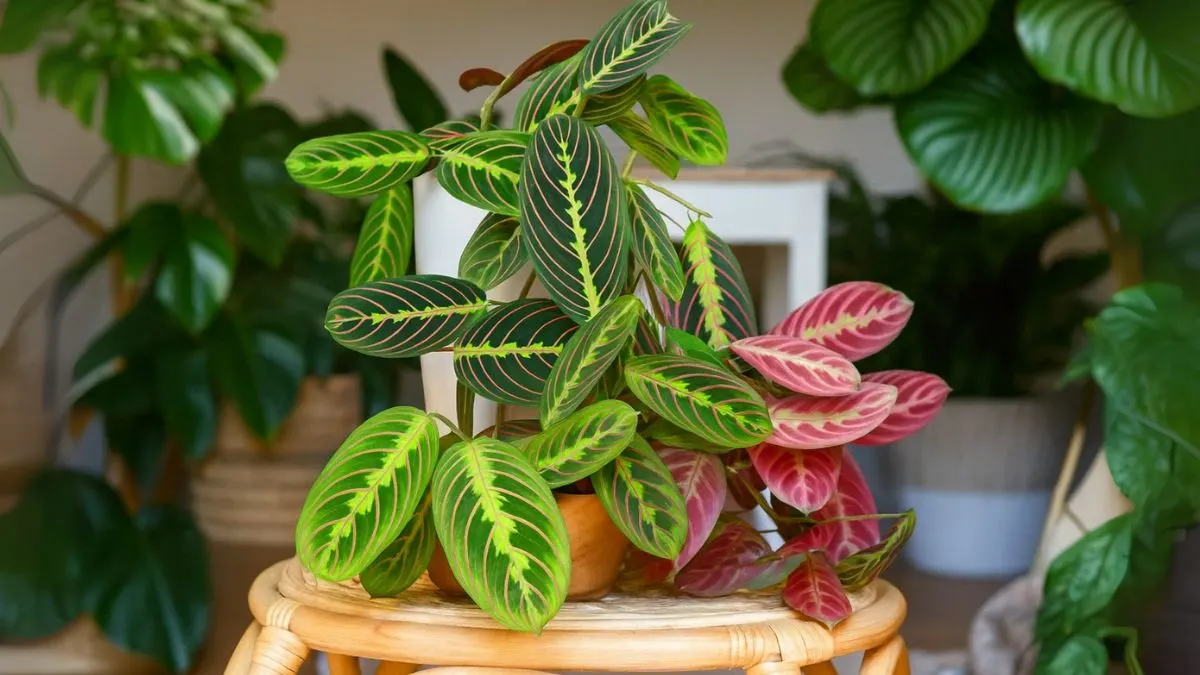The prayer plant (Maranta leuconeura) is one of the most fascinating indoor plants, known for its ability to fold its leaves upward in the evening, almost as if it’s praying. If you’ve ever walked into a room and noticed your plant has shifted its leaves overnight, that’s exactly why it’s so popular.
For beginners, prayer plants are a wonderful introduction to houseplant care. They are resilient, decorative, and easy to love—if you understand their needs. I’ve been growing prayer plants for years, and most of my prayer plants sit near a humidifier because they enjoy moisture in the air. Here’s how you can give yours the best start.
Provide the Right Lighting

One of the most important indoor prayer plant care tips for beginners is understanding light requirements. These plants provide bright, indirect light and avoid direct sun, which scorches leaves.
Place your prayer plant near an east-facing or north-facing window. If you only have south or west-facing windows, filter the light with sheer curtains. Move it to a shadier spot and allow it to cool down and revive itself if you notice yellowing or burnt edges.
Soil Requirements
Healthy roots are the foundation of healthy plants. Prayer plants require well-draining, loamy, and acidic soil to thrive indoors.
The soil should be rich in organic matter, slightly acidic, and capable of holding moisture without becoming soggy. In my experience, a mix of peat moss, perlite, and loamy garden soil works best. This way, the plant grows best in soil that drains well and is rich in nutrients.
Also Read: Jade Plant Lifespan: How Long Can This Hardy Succulent Live?
Watering Tips
Beginners often struggle with watering. Don’t overwater. Prayer plants don’t like soggy soil, but they also dislike being too dry. A good rule is: water your prayer plants when the top inch of soil feels dry.
During summer, you may need to water more frequently. In winter, cut back to avoid root rot. If your tap water is too hard, use filtered or distilled water to prevent leaf spotting.
Boosting Humidity
Prayer plants thrive in humid environments, which makes them excellent candidates for bathrooms or kitchens. But in drier climates like much of Canada or northern USA, you’ll need to add humidity.
- Use a pebble tray, place a humidifier nearby, or mist often.
- Grouping plants together also helps increase local humidity.
- As I mentioned earlier, most of my prayer plants near a humidifier look far healthier and display vibrant foliage.
Fertilization & Feeding
Prayer plants enjoy regular feeding during the growing season (spring and summer). Use a balanced, water-soluble houseplant fertilizer every 2-4 weeks at half strength. This ensures strong growth and keeps the foliage vibrant.
In fall and winter, reduce feeding to once a month or stop altogether, since growth naturally slows down.
Also Read: Surprising Places Where Custard Apples Grow Best
Up-Potting and Repotting
Another vital care tip is knowing when to repot. Up-potting helps refresh the soil and encourages a healthy, strong root system.
You don’t need to repot annually, but every 2-3 years, shift your plant into a slightly larger pot. Always refresh the soil, as nutrients deplete over time.
Common Problems and Fixes
Problem |
Likely Cause |
Solution |
Yellowing leaves |
Too much direct sun or overwatering |
Move it to a shadier spot and allow it to cool down and revive itself. |
Brown leaf edges |
Low humidity |
Use a pebble tray, place a humidifier nearby, or mist often. |
Wilting leaves |
Soil too dry |
Check soil moisture and water consistently. |
Stunted growth |
Lack of nutrients or compacted soil |
Fertilize regularly and consider up-potting. |
Why Beginners Love Prayer Plants
- They are interactive—watching leaves fold up at night is fun.
- Their patterned foliage adds color and character to indoor spaces.
- They adapt well indoors, making them ideal for small apartments or offices.
- With just a few key tips, they remain lush and healthy for years.
Also Read: A Simple Guide to Propagating Christmas Cactus
When I first started growing houseplants, my prayer plant was the one that survived my beginner mistakes. That resilience—and its stunning foliage—made it my favorite.
As they grow, up-potting helps refresh the soil and encourages a healthy, strong root system. With these simple prayer plant care tips for beginners, you’ll enjoy a lush, vibrant plant that thrives indoors.
So, if you’re ready to take your indoor gardening skills up a notch, the prayer plant is the perfect companion.






